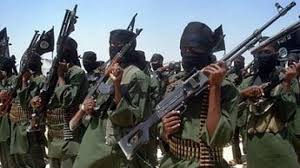Al Shabaab Militants Strike Again
Al Shabaab militants
NEW DELHI: In a brutal attack, Al Shabaab militants killed at least 36 non muslim quarry workers in northeast Kenya on Tuesday, claiming the attack was in response to Kenyan military action against the group in neighboring Somalia.
The attack took place in area near the Somalia border where, just a week ago, Al Shabaab militants killed 28 non muslim passengers on a bus bound for the Kenyan capital, Nairobi. The bus attack, the militants said, was revenge for police raids on mosques in Mombasa.
In both cases, militants separated muslims and non muslims, summarily killing the latter.
Following the attack on the quarry workers, Kenya’s president, Uhuru Kenyatta, fired the country’s security minister and accepted the resignation of the police chief. Addressing the nation, Kenyatta vowed to continue fighting against Al Shabaab, in Somalia and in Kenya. “We will not flinch or relent in the war against terrorism in our country and our region,” the president said, adding, “We shall continue to inflict painful casualties on these terrorists until we secure our country and region. Our stability and prosperity depends on a secure neighbourhood.”
“The obvious intent is to create hostility and suspicion across ethnic and religious lines and to drive non-Muslims from certain parts of this country. The ultimate aim of this atrocious campaign is to establish an extremist caliphate in our region,” Kenyatta said.
Al Shabaab militants have been in the international spotlight for their attacks in Kenya and Somalia, most recently explosions in Nairobi earlier this year and the infamous West Gate Mall attack that killed 67 people. The group took responsibility for the attack as retribution for the Kenyan government’s decision to send troops into Somalia to fight alongside government forces.
Al-Shabaab declared jihad on Kenya as far back as 2010 on allegations that the Kenyan government was training Somali troops, which Kenya denied. This threat was heightened post 2011 when the Kenyan government sent troops as part of a United Nations backed African Union force that pushed al-Shabaab militants out of Somalia's capital, Mogadishu in 2011, and out of the vital port of Kismayo in 2012. The port has been a vital asset for the militants, enabling supplies to reach areas under the group’s control and providing taxes for its operations.
After 2011, al-Shabaab’s influence in Somalia was reduced from control over large swathes of the country’s central and southern areas, including its capital, to limited rural areas. Kenyan troops continue to serve as part of the African Union force, playing a pivotal role in capturing areas from al-Shabaab’s control.
The al-Shabaab group carries out attacks within Somalia often. In March this year, the militants led a suicide raid on a hotel in the southern town of Buuloburde, killing a number of people days after the town was recaptured from the militants. The attack followed an assault on a military convoy near the capital city, killing four Somali soldiers. In February, 14 people were killed as the group attacked the Somali presidential palace although Somali president, Hassan Sheikh Mohamud, was unharmed.
Al-Shabaab’s control of parts of Somalia’s countryside and smaller towns is being used by the militants as a launchpad to plan and execute attacks in the country and beyond Somalia’s borders, examples being the attacks in Kenya. In addition to Kenya, the group has specifically targeted Uganda, also a neighbouring country that has contributed fighters to the African Union force. The deadliest attack in Uganda by the militant group killed 64 people in Kampala as they watched the World Cup final in 2010.
The group, which has links to Al-Qaeda, has denounced the 2012 election of President Hassan Sheikh Mohamud, which was backed by a UN-brokered peace process, as a foreign plot to control Somalia. The group’s rise to influence can be located within the political context of Somalia, which has lacked an effective national government for over twenty years, making the group’s promise of security appealing to the country’s population. The Somali government maintains that the group’s presence is on the decline and the militants are on the verge of being defeated. A Twitter account run by the President’s office posted, “Don't be fooled by this media spectacular [sic]. This is another act of desperation from a dying animal,” following the attack on the palace.
Is Al Shabaab a “dying animal”? These latest incidents prove otherwise.





